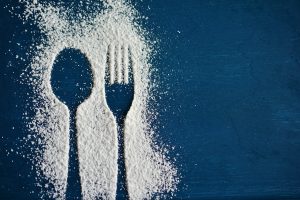The Ketogenic Diet: An Initial Research Overview
While the ketogenic diet has recently exploded in popularity for helping people lose weight, I wanted to review the research and see what we know about its effects. This is the first article in a series to cover aspects of the ketogenic diet.
What is the Ketogenic Diet?
The normal human diet is composed of three “macronutrients”. While you may not have heard this term before, I’m sure you’re familiar with them:
- Fats (oils and fats)
- Carbohydrates (sugars, starches and fiber)
- Protein (amino acids)
All weight loss diets generally adjust the ratios of how much of your food comes from these three components in an attempt to optimize weight loss.
Protein and fat are both essential nutrients, meaning you have to consume them or you will eventually get sick and/or die. Carbohydrates, however, appear non-essential. You can live without consuming them (Westman 2002). The Inuit Eskimos lived primarily without carbohydrates and there’s a fascinating study from the 1930s of two researchers living on meat and fat for a whole year without major negative health effects (McCllelan 1930). Now to be clear, I’m not specifically recommending a meat only diet, just showing the extremes of what’s possible.
For the ketogenic diet, the focus is primarily on the removal of almost all carbohydrates. There’s no grain or grain products, no beans, no fruit (with the exception of small amounts of berries) and no starchy vegetables. The diet consists mostly of meat, seafood, eggs, above ground vegetables, nuts and seeds, and some high-fat, low-carb dairy products. These foods can be varied somewhat, but in total, carbohydrates need to be kept between 20 and 50 grams per day (Masood 2019). Usually, the dominant macronutrient is fat, and protein is not consumed in excess. The diet is quite restrictive.
What Happens on a Ketogenic Diet?
When an individual drastically reduces carbohydrates, it forces their body to use fat for energy which is a state called ketosis (Boison 2017). Fat gets turned into ketone bodies which are burned throughout the body as fuel. Ketone bodies may be a part of the interesting benefits of the ketogenic diet since they have anti-seizure, neuroprotective (brain protective) and anti-inflammatory effects (Rho 2017, Maalouf 2009, Dupuis 2015).
Historically, the diet has been primarily used for treating seizure disorders in children and has been described in the literature as “remarkably effective” (Rho 2017). More recently, it’s become a popular choice for weight loss and studies show that low-carb diets may outperform the classic low-fat diet recommended for weight loss (Shai 2008, Gardner 2007). While these studies were some of the largest comparing low-fat and low-carb diets, they used an Atkins diet to achieve low carbohydrate levels which allows for more protein than a standard ketogenic diet. Even so, participants had significantly more weight loss on the low-carb diet when compared to low-fat; ~5.6 pounds weight loss on the standard low-fat diet compared to 10.4 pounds on a low-carb ketogenic diet.
Interestingly, cholesterol also improved the most on a low-carb diet as compared to higher carb diets (Shai 2008, Gardner 2007). Fears of heart disease risks being increased on a ketogenic diet still exist, although we have some long-term data that suggests otherwise. A study on children treated for 10 years with a ketogenic diet for a genetic problem where they can’t transport blood sugar into the brain revealed no increased risk factors for heart disease from following the diet long-term (Spalice 2018).
Some Additional Long-Term Concerns
There are data that suggests increased mortality on very low carbohydrate or ketogenic diets (Seidelmann 2018, Banach 2018). Digging deeper, increased death was tied to higher consumption of fat and protein from meat or animal sources. Ketogenic diets that emphasized high plant consumption eliminated the risk. When prescribing a “healthy” ketogenic diet, I’ve always recommended high amounts of healthy plant fats and plant-based protein like olive oil, nuts and seeds along with avoiding excessive meat consumption more commonly associated with an Atkins-style ketogenic diet.
In addition, on a ketogenic diet, even though bacon, ham, (processed meat) and red meat are allowed, a wise approach is likely to limit their consumption due to their well-known health risks (Battaglia Richi 2015). This recommendation was challenged recently by a largely publicized study claiming there’s no good evidence for decreasing red and processed meat consumption for health benefits (Johnston 2019). Studies like this are incredibly frustrating to the general public and make our job as doctor’s more difficult when we try to help a patient improve their diet due to all the confusing and contradictory information. Personally, I think there’s reasons to take this review article with a grain of salt. Discussing the findings could easily make another blog article.
Other Potential Concerns of the Ketogenic Diet
Studies following children using a ketogenic diet for seizures have revealed some concerns with long-term effects. Kidney stones over an 8 year period occurred in 8.8% of the children. There was also some suggestion that bone mineral density was lower than average on a ketogenic diet (Draaisma 2019). Another study showed progressive loss of bone mineral content with a ketogenic diet in children (Bergovist 2008). In contrast to these findings, a separate study showed that a modified low carbohydrate diet may reduce or eliminate the bone health problems in children (Svedlund 2019). The problems with bone health may only apply to children on more restrictive ketogenic diets. In adults, there are a few studies that showed no change in bone health parameters with long-term ketogenic diets, which is reassuring (Brinkworth 2016, Foster 2010, Krebs 2010)
The Ketogenic Diet and the Kidneys
There’s often discussions around the ketogenic diet being damaging to the kidneys. Some evidence appears to support the claim if the diet has excess protein. However, there’s also evidence for actual improvements in kidney function if protein is not in excess. A mouse study with a low carbohydrate, high protein and high fat diet showed increases in the albumin/creatinine ratio, an early marker of kidney disease and damage (Handa 2016). The problem here seems to be the excess protein.
In a separate study of diabetic mice based on a ketogenic diet with high fat, adequate protein and low carb, they saw reversal of kidney disease (Poplawski 2011). In addition, a small human study showed improvement in kidney function in a short-term, calorie-restricted ketogenic diet for patients with diabetic kidney disease (Friedman 2013). Improvements in kidney function may be possible on a properly balanced ketogenic diet. Considering the challenges in treating progressive kidney disease, we need more research to verify these findings.
Other common side effects of the ketogenic diet are gastrointestinal. People can get what is called the keto flu when starting the diet, feeling sick with gastrointestinal side effects including nausea, vomiting, diarrhea and constipation (Klein 2010). Generally, these side effects aren’t serious, but they can be distressing.
Another huge concern about the ketogenic diet is its restrictive nature. You can’t eat some very common staple foods: No bread, no pasta, no potatoes, no bananas, no rice and no beans. Having explored the effects of different diets on my own health, I’m acutely aware of the challenges and social ramifications of eating a more restrictive diet.
My Thoughts on the Ketogenic Diet
Based on all the research presented above, you may assume I recommend the ketogenic diet frequently. In reality, I don’t prescribe it often due to the unique challenges of implementing such a restrictive diet. I find it fascinating, especially with all the recent research on anti-inflammatory effects but I’m very selective in its recommendation. In general, I’m more likely to prescribe a diet that reduces sugar and processed foods while increasing vegetables. I’ve also seen benefits from gluten free diets, although I know that raises some controversies on its own.
In people interested in the ketogenic diet it’s VERY important to do it right. A ketogenic diet is not an excuse to shun vegetables, or to eat bacon and salami for breakfast, lunch and dinner. It still requires careful food choices and a balanced approach to protein, especially animal protein.
In future articles I’ll touch on some of the research around ketosis and ketogenic diets on diabetes, brain health and cancer. These conditions are when I’m most inclined to prescribe a low-carb, ketogenic approach as the research suggests potential important benefits for these conditions.



